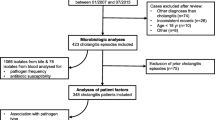Summary
The biliary elimination of cefotaxime (CTX) and its metabolite desacetylcefotaxime (DSCTX) were measured by HPLC in nine recently cholecystectomised patients following the i. v. injection of 15 mg/kg body weight of CTX. All of the bile was collected by an original procedure: the inflated balloon of a Fogarty catheter was introduced into the distal branch of a Kehr drain T-tube. Biliary clearance of CTX and DSCTX was measured for 8 h. Cefotaxime peaked at 90 min after injection at 34.5 ± 15.3 mg/l; in the 7–8 h sample it was 2.7 ± 1.7 mg/l. DSCTX peaked at the same time at 49.3 ± 17.0 mg/l, and was 4.6 ± 3.2 mg/l at 8 h. The bile/serum ratio of CTX and DSCTX concentrations was above 1 from the first to the eighth hours (range: 1.35 ± 1.08 to 11.0 ± 3.1). The biliary clearance of CTX was 0.190 ml/min. The total amounts of CTX and DSCTX eliminated in bile were respectively 1050 ± 472.8 µg and 1902.7 ± 804.1 µg (0.093 ± 0.041% of the dose and 0.186 ± 0.077% of the dose). Considering the minimum inhibitory concentration of the pathogens currently encountered in biliary sepsis, CTX should be a suitable antimicrobial agent for the treatment of biliary infections.
Zusammenfassung
Die Gallenausscheidung von Cefotaxime (CTX) und dessen Metaboliten Desacetylcefotaxime (DSCTX) werden bei 9 kürzlich cholezystektomierten Patientinnen nach einer intravenösen Injektion von 15 mg/kg Körpergewicht CTX gemessen. Die gesamte Galle wurde durch ein spezielles Vorgehen gesammelt: der aufgeblasene Ballon eines Fogarty Katheters wurde in den distalen Zweig eines Kehr-T-Drains eingeführt. Die biliäre Clearance des CTX und des DSCTX wurde während 8 Stunden gemessen. Die CTX-Konzentration erreichte Spitzenwerte von 34,5 ± 15,3 mg/l 90 Minuten nach der Injektion. Diese Werte sanken auf 2,7 ± 1,7 mg/l nach 7–8 Stunden. DSCTX erreichte seine Spitzenkonzentration zur gleichen Zeit mit 49,3 ± 1,7 mg/l und fiel auf 4,6 ± 3,2 mg/l nach 8 Stunden. Das Konzentrationsverhältnis Galle/Serum von CTX und DSCTX blieb bei 1 während der ganzen Probezeit (Mittelwerte 1,35 ± 1,08 bis 11,0 ± 3,1). Die biliäre Clearance von CTX war 0,190 ml/min. Die Gesamtmenge an in der Galle ausgeschiedenem CTX und DSCTX betrug 1050 ± 472,8 µg bzw. 1902,7 ± 804,1 µg (0,093 ± 0,041% bzw. 0,186 ± 0,077% der Dosis). Wenn man die minimalen Hemmkonzentrationen der häufigsten Erreger bei biliärer Sepsis betrachtet, scheint CTX ein geeignetes Antibiotikum für die Behandlung von biliären Infektionen zu sein.
Similar content being viewed by others
Literature
Labaune, J. P. La clairance hépatique. In: Pharmacocinétique, principes fondamentaus. Masson, Paris 1984, pp. 175–205.
Kees, F., Strehl, E., Dominiak, P., Grobecker, H., Seeger, K., Seidel, G., Neuhaus, B., Safrany, L. Cefotaxime and desacetylcefotaxime in human bile. Infection 11 (1983) 118–120.
Krausse, R., Ullmann, V., Brandstetter, G., Kratochvil, P. Investigation of human bile and serum levels by high pressure liquid chromatography after administration of latamoxef or cefotaxime. Arzneim. Forsch./Drug Res. 34 (1984) 1787–1791.
Shyu, W. C., Nightingale, C. H., Quintiliani, R., Rosa, D., Rosson, R., Owens, N., Helmink, R. Biliary excretion of cefotaxime. Curr. Ther. Res. 35 (1984) 727–734.
Soussy, C. J., Deforges, L. P., Le Van Thoi, J., Feghali, W., Duval, J. R. Cefotaxime concentration in the bile and wall of the gall-bladder. J. Antimicrob. Chemother. 6 Suppl. A (1980) 125–130.
Wise, R., Wills, P. J., Andrews, J. M., Bedford, K. A. Activity of the cefotaxime (HR 756) desacetylmetabolite compared with those of cefotaxime and other cephalosporins. Antimicrob. Agents Chemother. 17 (1980) 84–86.
Jones, R. N., Barry, A. L., Thornsberry, C. Antimicrobial activity of desacetylcefotaxime alone and in combination with cefotaxime: evidence of synergy. Rev. Infect. Dis. 4 (1982) S366-S 373.
Neu, H. C. Antibacterial activity of desacetylcefotaxime alone and in combination with cefotaxime. Rev. Infect. Dis. 4 (1982) S 374-S 378.
Jehl, F., Monteil, H., Minck, R. Mise au point et intérêt du dosage de cinq béta-lactamines à l'aide de la chromatographie liquide à haute performance. Pathol. Biol. 31 (1983) 370–374.
Jehl, F., Birkel, P., Monteil, H. Hospital routine analysis of penicillins, third-generation cephalosporins and aztreonam by means of conventional and high speed HPLC. J. Chromatogr. 413 (1985) 109–119.
Gibaldi, M., Perrier, D. Clearance Concepts. In: Pharmacokinetics, 2nd ed. Marcel Dekker, Inc., New York and Basel 1982, pp. 319–353.
Rollins, D. E. Pharmacokinetics and drug excretion in bile. In:Benet, L. Z., Massoud, N., Gambertoglio, J. G. (eds.): Pharmacokinetic basis for drug treatment. Raven Press, New York 1984, pp. 77–88.
Höffken, G., Lode, H., Koeppe, P., Ruhnke, M., Borner, K. Pharmacokinetics of cefotaxime and desacetylcefotaxime in cirrhosis of the liver. Chemother. 30 (1984) 7–17.
Chamberlain, J., Combes, J. D., Dell, D., Fromson, J. M., Ings, R. J., McDonald, C. M., McEwen, J. Metabolism of cefotaxime in animals and man. J. Antimicrob. Chemother. 6 Suppl. A (1982) 69–78.
McDonald, C. M., Fromson, J. M., McDonald, A., Dell, D., Chamberlain, J., Combes, J. D. Disposition of cefotaxime in rat, dog and man. Arzneim. Forsch./Drug Res. 34 (1984) 1719–1723.
McDonald, C. M., McDonald, A., Fromson, J. M., Combes, J. D. Cefotaxime: Sites and pathway of metabolic conversion. Arzneim. Forsch./Drug Res. 34 (1984) 1729–1735.
Guggenbichler, J. P., Kofler, J., Allerberger, F. The influence of third-generation cephalosporins on the aerobic intestinal flora. Infection 13 Suppl. 1 (1985) S 137-S 139.
Knothe, H., Dette, G. A., Shah, P. M. Impact of injectable cephalosporins on the gastrointestinal microflora: observations in healthy volunteers and hospitalized patients. Infection 13 Suppl. 1 (1985) S 129-S 133.
Author information
Authors and Affiliations
Rights and permissions
About this article
Cite this article
Jehl, F., Peter, J.D., Dupeyron, J.P. et al. Investigation of the biliary clearances of cefotaxime and desacetylcefotaxime by an original procedure in cholecystectomised patients. Infection 15, 450–454 (1987). https://doi.org/10.1007/BF01647231
Received:
Accepted:
Issue Date:
DOI: https://doi.org/10.1007/BF01647231




